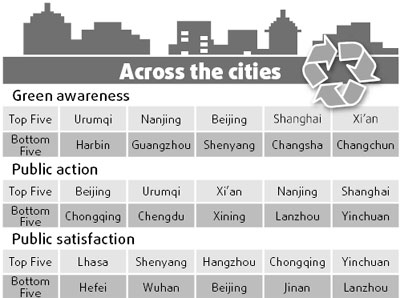The greater the public awareness, the more active the protection campaign and action to save the environment will be. It would also mean a lower public satisfaction level with the existing state of environmental affairs.
These are the main findings of a nationwide survey conducted by the China Environmental Culture Promotion Association, under the State Environment Protection Administration (SEPA).
Zhejiang Forestry College students get a feel of a "tree" made from soft drink cans and other wastes. The "tree" was "planted" in Hangzhou to promote green awareness and solicit opinions on what people can do to protect the environment.
Public awareness and protection steps are urgently needed to improve the deteriorating environment, show the survey results, in which public awareness on environmental protection was 42.1 out of 100, action 36.6, and satisfaction 44.7.
"The three major indices scored poorly," association Secretary-General Wang Panpu said yesterday, the day the survey was released. It raises concern, too, over the extent of public involvement in environment protection.
That only 13 percent of the respondents thought they were playing an important role in protecting the environment raises real worries. The survey concludes that public initiatives have not been strong because almost half the respondents didn't think they had made any substantial contribution to improving the environment. This means the country hasn't succeeded in its public awareness campaign.
The survey has been carried out every year since 2005. But this is the first time it covered the 31 capitals of the mainland's provinces and autonomous regions, interviewing more than 9,000 people.
Public awareness in Beijing, for instance, is third on the list, with action being at the top. Residents in Jinan and Lanzhou in Shandong and Gansu provinces were the most worried about the environment followed by those in Beijing. Incidentally, Jinan and Lanzhou are among the worst polluted cities in the country.
The survey, which focused on people's livelihood, too, showed environmental pollution has undermined daily life, from food and clothing to housing and transport.
More than 60 percent of the respondents were worried that a deteriorating environment could harm food security, making it by far the greatest public concern. About 40 percent feared interior decoration material could be harmful. Another 40 percent saw clothing material as a health hazard.
Water was a major concern, too: more than 30 percent of the respondents thought it was the biggest fallout of environmental damage, 20 percent were not content with the quality of water supplied to residential areas, and another 20 percent were nervous about drinking water provided in public places.
Conversely, the survey found that public awareness on water problems was poor and had to be improved. About 60 percent of the respondents, for example, didn't know what caused last summer's algae outbreak in Taihu Lake, and more than 50 percent didn't know that about 70 percent of the country's major rivers were polluted and all runoffs in urban areas were harmful.
Poor public awareness is especially surprising when 26 percent of the respondents said they were suffering because of a seriously polluted environment.
SEPA Vice-Minister Pan Yue nailed the problem, saying: "Since environmental pollution poses an increasing threat to human health, environmental protection has become synonymous with human rights protection." Public participation is the most important element in the country's green drive. How to use public power to improve the environment is a major issue for the government this year.
Some of the survey's other important findings are:
66.9 percent of the respondents think the country faces a serious environmental problem;
Only 2.7 percent don't treat environmental pollution as a serious threat;
73.1 percent support the green GDP that shows how much environmental damage has economic growth caused. More than 73 percent hope the green GDP, issued only for 2004, would continue;
44 percent believe short-term economic returns are the main reason for deterioration of the environment, and 58 percent say industries pay attention only to self-development and ignore the environment;
80 percent acknowledge the government's efforts to protect the environment;
More than 64 percent think the central government treats environmental issues "seriously" or "relatively seriously";
44 percent agree (and 37 percent agree to some extent) that loans should be granted only to those companies that guarantee no damage would be done to the environment.
(China Daily January 8, 2008)







